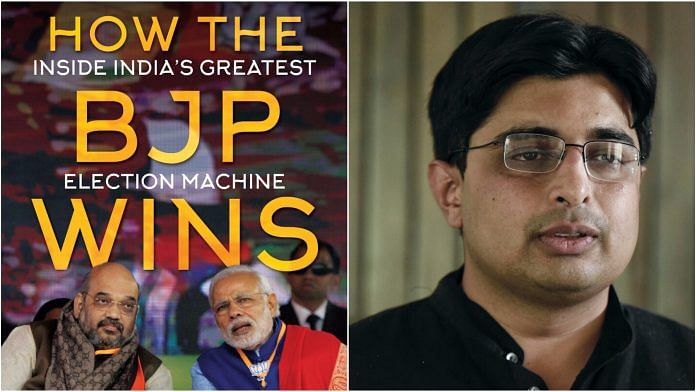How the BJP Wins by Prashant Jha explains that Modi’s mass appeal, Amit Shah’s organisational skills and failures of the opposition have contributed to BJP’s success.
The story of the rise and success of the BJP in the past five years has been a chronicle of the transformation of the BJP by its leadership. Prashant Jha’s book How the BJP Wins explains that Narendra Modi’s mass appeal, Amit Shah’s organisational skills, their social engineering strategies, the communal polarisation and the hopeless incapacities of the Opposition have contributed to the success of the party.
While the book makes Prime Minister Modi the centrepiece of analysis, it makes interesting comments on the contribution of Amit Shah to developing a ‘School of Election Management’, fine-tuned through decades of experience in managing successful electoral campaigns. The strategy involved galvanizing BJP cadres, micro-managing the party machinery, bringing in new talent and most importantly, making the ‘party unit at the booth level its heart and soul’. An added factor that has contributed to the success of the Modi-Shah model of leadership is the ‘complimentarity’ they represent and the implicit faith and trust that they repose in each other’s organisational capacities and political insights.
Two points that flow from Jha’s analysis merit attention. Firstly, the manner in which Narendra Modi’s multiple levels of appeal was consciously constructed. For the poor, he was projected as the ‘messiah’; for the upper and middle-class, he was the projected as the symbol of progress and for the hardcore BJP supporters, he represented a committed spokesperson of Hindu nationalism. As the party enters a phase of multiple challenges, one would need to wait and watch whether the same ‘multiple faces’ of its leadership would remain an advantage or emerge as a hollow contradiction.
An example in this regard would be demonetisation, which is discussed extensively in the book. The author rightly makes the point that demonetisation was very skillfully projected and presented to the voter. The book asserts that while the note ban move had inconvenienced people a great deal, they were willing to accept the small irritations to be part of a larger nation-wide cleansing and economic reform drive.
Two caveats need to be added. Firstly, in all the states that went to the polls (except Punjab and Goa), where the BJP was not the incumbent in power and was vigorously attacking the ruling party/alliance. In such a situation, one could craftily shift demonetisation to the back-burner and focus attention on the popular dissatisfaction with the state government.
In many of the state elections that we now face, the BJP is defending its record in government as the ruling party. Secondly, in the recent past, there seems to be a visible shift in public mood over demonetisation and the Gujarat and Karnataka elections would be interesting indictors of the same.
This brings us to another interesting point made by the author. The success of the BJP in successive elections is also on account of the inability of those in the opposition to seize the advantage. The BJP was successful in positioning the 2014 campaign as a leadership referendum between Narendra Modi and Rahul Gandhi. The author rightly argues that Rahul Gandhi has little to show in terms of his `track record` and his communication skills leave much to be desired.
In this context, the new strategy of the party is interesting. Rather than projecting the national leadership of the Congress, the party is placing a premium on state-level leader, be it Capt. Amarinder Singh, Siddaramaiah, Sachin Pilot or a Jyotiraditya Scindia. This has already paid dividends in Punjab and had led to a tough contest in Karnataka earlier.
If the Congress is able to shift the focus of electoral debates away from leadership to issues and make the best of the presence of its mass-base leaders at the state level, the BJP is likely to face serious challenges, especially when it is defending its record as the ruling party.
In the last chapter, ‘The Future of the Hegemon’, Jha draws attention to the way forward. Four issues merit elaboration. Firstly, ‘Brand Modi seems to be Brand BJP’ . With every passing day the nucleus of the BJP and its election machinery appears to be its prime minister. Since the times of Indira Gandhi, one has not seen a PM with as much visibility and effectiveness in electoral campaigns.
Secondly, the BJP today is attempting to reconcile multiple contradictions to take all segments along. If these contradictions sharpen and transform into a greater conflict, would the party continue to be in a position to reconcile them?
Thirdly, the constant re-surfacing of low-intensity religious conflicts leads to the impression that the core ‘Hindutva’ value that the party and its leadership stands by will continue to hold sway. Is this emerging polarisation that one is increasingly witnessing leading to new contradictions and challenges in the long run?
Finally, will those opposed to the BJP be able to provide a credible and acceptable policy alternative that resonates with popular sentiment? This of course will be the biggest test for the BJP and its current leadership. Prashant Jha’s analysis draws attention to these important political trends and the possible pathways for the future.
The author is Pro Vice-Chancellor, Jain University







There is no real depth in the article and it does no justice to its headline. From nowhere to nothing.